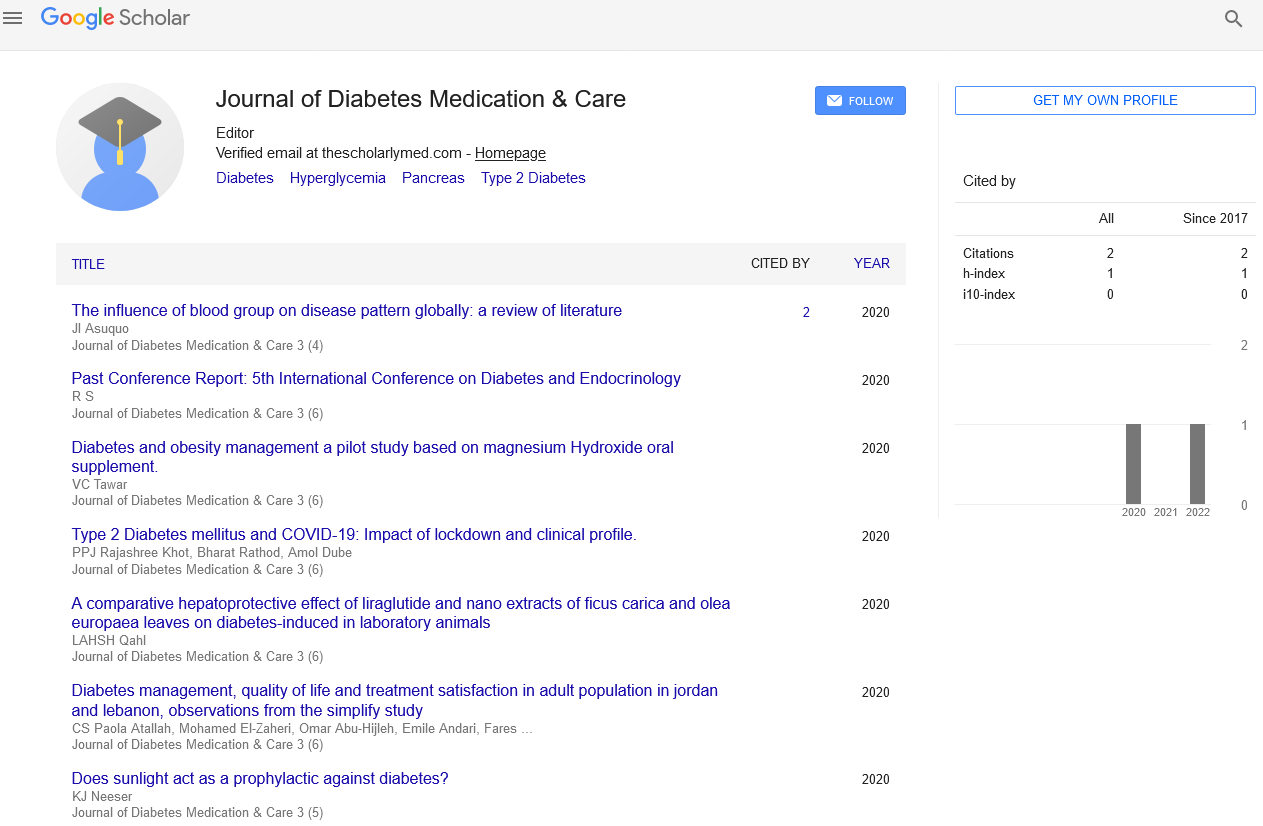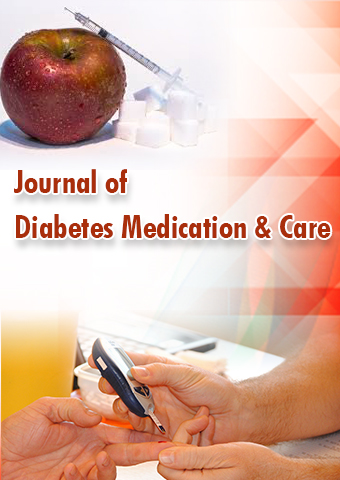Commentary - Journal of Diabetes Medication & Care (2022) Volume 5, Issue 3
A commentary on Effect of Chebulagic Acid from the Fruits of Terminalia chebula Retz.
Li-Rong Jia*
llege of Light Industry, Textile and Food Engineering, Sichuan University, Chengdu 610065,China
llege of Light Industry, Textile and Food Engineering, Sichuan University, Chengdu 610065,China
E-mail: jialirong@scu.edu.cn
Received: 02-Jun-2022, Manuscript No. jdmc-22- 36513; Editor assigned: 06-Jun-2022, PreQC No. jdmc-22- 36513 (PQ); Reviewed: 20-Jun-2022, QC No. jdmc-22-36513; Revised: 23- Jun-2022, Manuscript No. jdmc-22- 36513 (R); Published: 30-Jun-2022 , DOI: 10.37532/jdmc.2022.5(3).56-57
Abstract
In the present study, we firstly compared rat intestinal α glucosidase inhibitory activity by different ethanol-aqueous extractions from the dried fruits of Terminalia chebula Retz. The enzymatic assay showed that the 80% ethanol extract was more potent against maltase activity than both 50% and 100% ethanol extracts. By HPLC analysis, it was determined that the 80% ethanol extract had a higher content of chebulagic acid than each of 50% or 100% ethanol extract. Next, we investigated how efficiently chebulagic acid could inhibit sugar digestion by determining the glucose level on the apical side of the Caco-2 cell monolayerThe results presented here suggest that chebulagic acid from T. chebula can be used to control blood glucose and manage type 2 diabetes, although clinical trials are needed.
Keywords
Terminalia • chebulachebulagic acid • α-glucosidase inhibitor • antihyperglycemia
Introduction
Diabetes mellitus (DM) is a common metabolic disorder characterized by hyperglycemia, which is the main cause of complications related with micro- and macro-vascular diseases. DM is one of the three leading causes of death worldwide and constitutes a major health problem . Postprandial hyperglycemia results from abnormal insulin secretion by β-cells in response to a meal, impaired hepatic glucose production, and defective glucose uptake by peripheral insulin-sensitive tissues, particularly the skeletal muscles. Therefore, control of postprandial plasma levels is critical in treatment of not only diabetic patients but also individuals with impaired glucose tolerance. Mammalian intestinal α glucosidase (EC 3.2.1.20) is the key enzyme, which catalyzes the final step in the digestive process of carbohydrates. Hence, α-glucosidase inhibitors can reduce postprandial blood glucose levels and absorption of starch and disaccharides .
we compared rat intestinal α-glucosidase inhibitory activity of different ethanol-aqueous extractions and\ detected chebulagic acid in these extracts by HPLC analysis. Meanwhile, we determined α-glucosidase inhibitory activity of chebulagic acid with the Caco-2 cell monolayer, together with evaluating the postprandial blood glucose lowering effect of chebulagic acid after sugar (maltose, sucrose or glucose) loading in Sprague-Dawley (SD) rats.
Description
Extraction of phenolic compounds from T. chebula is generally carried out using various types of organic solvents such as 95% ethyl acetate, hot water, 70% methanol, and 95% ethanol. Ethanolic extraction of plant bioactives has displayed a higher yield compared with the aqueous extract . In the present study, we compared rat intestinal α-glucosidase inhibitory activity of different ethanol-aqueous extractions.the maltose-hydrolysis inhibitory activity of 50–100% ethanol extracts of T. chebula fruits. Each of these ethanol extracts significantly inhibited the maltase activity, and the enzymatic inhibition was dose ndependent. In the same assay condition, the IC50 value of chebulagic acid was determined to be 37 μg/mL . On the other hand, the IC50 values of 50%, 80% and 100% ethanol extracts against maltase were determined to be 173.6 μg/mL, 51.7 μg/mL and 85.7 μg/mL, respectively. Hence, this result revealed that the 80% ethanol extract was more potent regarding its effect on maltase activity than both 50% and 100% ethanol extraction.
In the present study, we compared rat intestinal α-glucosidase inhibitory activities of different ethanol-aqueous extractions from the dried fruits of T. chebula. The enzymatic assay showed that the 80% ethanol extract had a more potent effect on maltase activity than both 50% and 80% ethanol extracts. HPLC analysis revealed that the 80% ethanol extract contained a higher content of chebulagic acid than either the 50% or 100% ethanol extract. In a Caco-2 cell model, α-glucosidase activity for maltose hydrolysis was down-regulated by chebulagic acid, which is a reversible inhibitor of maltase. On the other hand, chebulagic acid showed a weak inhibition of sucrose-hydrolysis activity and did not affect intestinal glucose uptake by Caco-2 cells. Furthermore, chebulagic acid significantly reduced postprandial blood glucose level in maltose-loaded SD-rats. So, it was suggested that chebulagic acid from T. chebula may be useful for suppressing postprandial hyperglycemia as a potent antidiabetic agent, although clinical trials are needed.
Acknowledgement
None
Conflict of Interest
No conflict of interest
References
- Lebovitz HE. alpha-Glucosidase inhibitors. Endocrinol. Metab. Clin. North Am. 26, 539–551 (1997).
- Yao Y, Cheng XZ, Wang LX et al. Determination of potential α glucosidase inhibitors from azuki beans (Vigna angularis). Int. J. Mol. Sci. 12, 6445–6451 (2011).
- Kim SH, Jo SH, Kwon YI et al. Effects of onion (Allium cepa L.) extract administration on intestinal α-glucosidases activities and spikes in postprandial blood glucose levels in SD rats model. Int. J. Mol. Sci.12, 3757–3769 (2011).
- Gao H, Huang YN, Gao B et al.α-Glucosidase inhibitory effect by the flower buds of Tussilago farfara L. Food Chem. 106, 1195–1201 (2008).
- Srivastava P, Raut HN, Wagh RS et al. Purification and characterization of an antioxidant protein (~16 kDa) from Terminalia chebula fruit. Food Chem.131, 141–148 (2012).
Indexed at, Google Scholar, Crossref
Indexed at, Google Scholar, Crossref
Indexed at, Google Scholar, Crossref
Indexed at, Google Scholar, Crossref

